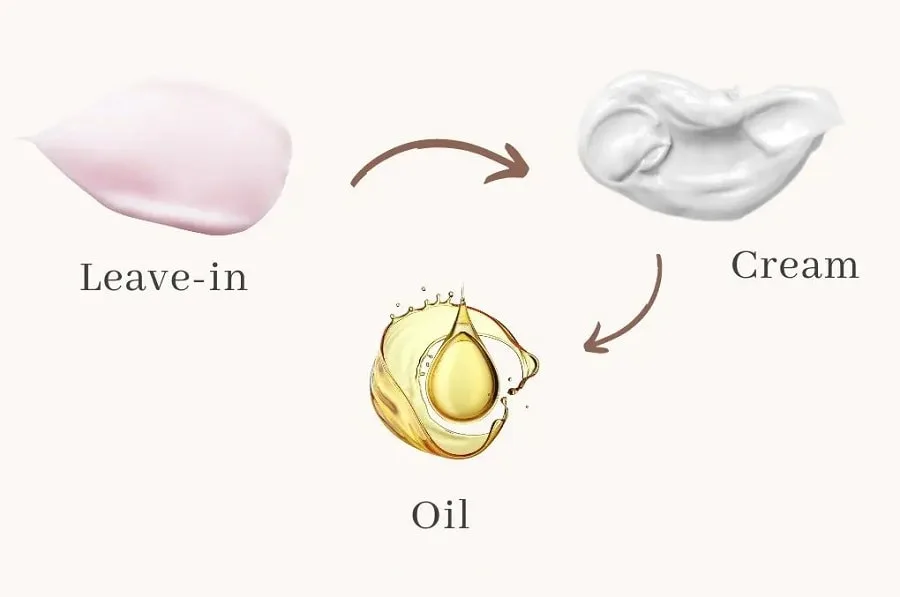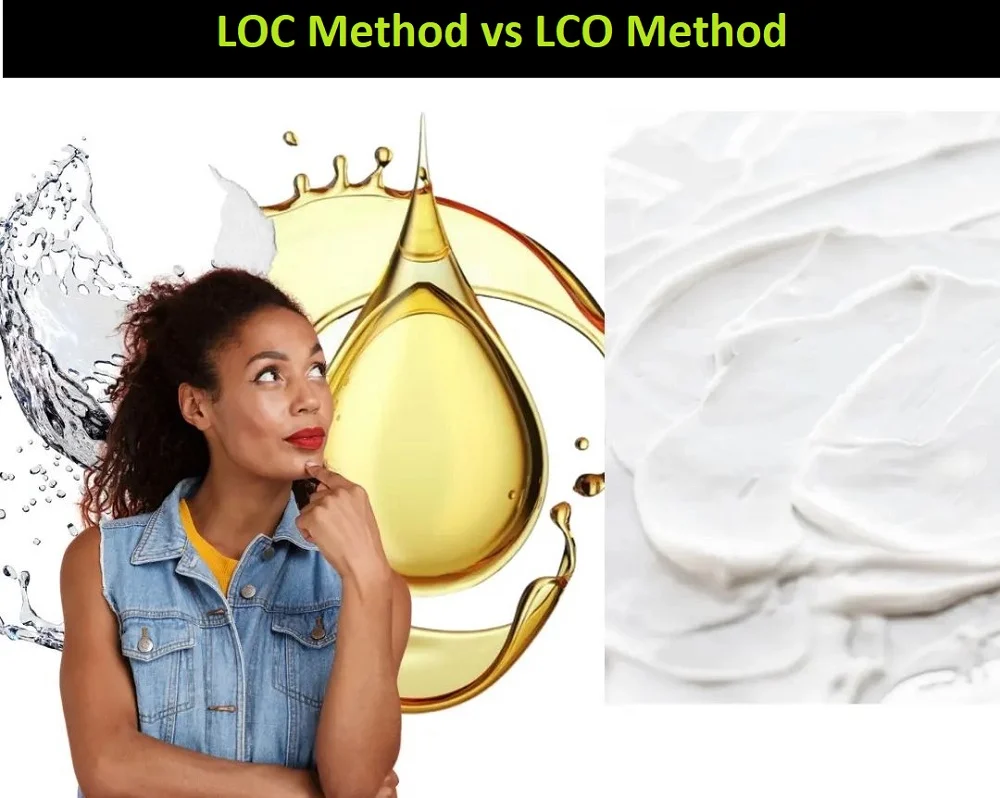Moisturizing your hair is a science, and experts have narrowed it down to LOC and LCO methods. But how does LOC vs. LCO compare? When and how should you use them?
These two moisturizing methods work by layering different densities of hair products on your hair. They work by taking advantage of your hair’s porosity to optimize moisture absorption and retention.
In both methods, the L represents liquid or leave-in conditioner, the O represents oil, and the C represents cream.
If are interested in knowing the differences and how to choose between LOC and LCO, read this article till the end.
What Is LOC Method?

LOC is a moisturizing technique where you layer the liquid first into the hair to hydrate it, then seal the moisture with oil. You then use a cream to lock in moisturizers and prevent frizz.
This method is excellent for highly porous hair. High porosity hair has no problem absorbing moisture. However, it loses it just as fast, which can be frustrating when maintaining natural hair.
With the LOC method, the liquid hydrates the hair rapidly. The oil seals the liquid moisturizer into the hair strand, preventing it from drying.
A layer of cream provides additional protection to prevent moisture from escaping. This layer of cream doesn’t penetrate the hair cuticle, preventing hair from becoming over-moisturized.
Pros and Cons of LOC
Here are some benefits and drawbacks of LOC method:
Pros
- Great at moisturizing dry hair
- Minimizes frizz
- Protects hair from damage
- Can improve the definition of your curls
Cons
- Too much product could weigh down your hair
- Not suitable for fine or thin hair
What Is LCO Method?

The LCO hair moisturizing technique involves layering the liquid first, followed by cream, and then oil. This method works well for low-porosity hair, which absorbs moisture rather slowly.
This method helps low-porosity hair lock in moisture without weighing it down with too much product. It also enhances the appearance of the hair by smoothing it out and minimizing frizz.
Pros and Cons of LCO
Here are some benefits and drawbacks of LCO method:
Pros
- Softens and moisturizes hair
- Prevents frizz
- Great for low-porosity hair
Cons
- It takes longer to dry
- It requires trial and error with various products before you find the combination that works best
Differences Between LOC and LCO Methods

Hair Porosity
High porosity hair absorbs and loses moisture fast, meaning it’s prone to dryness and brittleness. Low porosity hair, in contrast, has problems absorbing moisture.
LOC and LCO methods suit different hair porosities. LOC is best for high-porosity hair, while LCO works well for low-porosity hair.
Hair Type
Another difference in LOC vs. LCO is the hair types they work best for. The LOC moisturizing technique works best for curly hair, which benefits from the heavy products used in this method.
The LCO method, on the other hand, uses lighter products, making it ideal for wavy to curly hair. The main advantage of the LCO method is that it doesn’t weigh down the hair, yet provides moisture and minimizes frizz.
Hair Texture
Your hair’s texture can affect how it holds moisture. Coarse and thick hair calls for the LOC moisturizing method, as the heavy products help keep the hair together and trap moisture.
Fine and thin hair, on the other hand, works well when moisturized with the LCO method. This method uses lighter products that do not weigh down fine hair.
Application
The application procedure is the major difference between LOC and LCO.
The first step in both moisturizing techniques begins with water or a water-based product for initial hydration.
You start the application process in LOC with a liquid or leave-in conditioner, an oil, and then a cream. In LCO, you start with the liquid, then apply crème, before sealing it with oil.
Products
Both LOC and LCO methods use a liquid, cream, and oil. In both moisturizing techniques, the base liquid is a water-based moisturizer since oil-based moisturizers dry out hair.
However, the cream and oil vary between the two methods. Highly porous hair is prone to losing moisture. It requires heavier oils (coconut or castor) and creams to lock in moisture and prevent the hair from frying out.
The heaviness of the cream used in the LOC method keeps the hair strands together, further protecting moisture.
On the other hand, low-porosity hair requires lighter products with more humectants. These products can keep the hair hydrated and frizz-free without weighing down the hair.
Maintenance
LOC and LCO have different maintenance requirements. The LOC technique uses heavier products to moisturize the hair. This could result in more product build-up in the hair and scalp, necessitating more maintenance.
On the contrary, the LCO moisturizing technique uses lighter products that do not weigh down the hair or cause too much build-up. Therefore, it might require less frequent washing than hair moisturized using LOC.
Here is a table that shows the significant differences between LOC and LCO.
| Characteristics | LOC | LCO |
|---|---|---|
| Hair porosity | High | Low |
| Hair Type | Curly to coily | Wavy to curly |
| Hair Texture | Coarse and thick | Fine and thin |
| Application | Liquid > Oil > Cream | Liquid > Cream > Oil |
| Products | Heavy | Lighter |
| Maintenance | Requires frequent washing to prevent product build-up | Less washing required |
LOC Vs. LCO Method: Which One to Choose for Your Hair?

Getting the right moisturizing technique is a matter of experiment. It’s advisable to try out the two moisturizing techniques and see which works best for your situation. Here are a few factors to help with your decision.
- Your lifestyle should be a deciding factor. How much time do you have for caring for your hair? Since LOC uses heavier products, it might also mean more frequent hair washing during the week, especially if you have an oily scalp.
- Your hair’s moisture needs should be the primary consideration when choosing LOC vs. LCO. If your hair is prone to drying out quickly after taking in moisture, LCO is the best technique to moisturize and lock in that moisture. The LCO technique is the best choice for dealing with low-porosity hair.
- Your hair type and texture also affect the moisturizing technique you choose. LOC works well with curly and coarse-textured hair, while LCO works well with 3a/3b and fine-textured hair.
Some people don’t know the best method until they experiment with various product combinations and moisturizing techniques. Therefore, experiment with each technique for a few weeks before settling on one.
Work with different product combinations during experimentation to find one that works well for your hair.
So, LOC is the best choice for anyone with high-porosity hair, while LCO suits people with low-porosity hair. Both methods work well for you if your hair falls with medium porosity.
If you’re still confused between LOC vs. LCO, try both methods and see how your hair performs on each. Let’s know the outcome.
FAQs
LCO is the best moisturizing method for low-porosity hair since it uses lightweight products that the hair absorbs easily.
The LOC method works best for dry hair. This method introduces moisture and then seals it to keep your hair moisturized.
Yes, you can do LCO or LOC daily, but it’s not advisable. Since you’re not washing your hair daily, using these moisturizing techniques every few days or once a week is best to prevent product build-up.
The LOC method is the best for 4C hair as it allows your hair to retain moisture for longer. With the LOC method, you first introduce moisture into your hair, seal it with oil then close the cuticles with cream.
